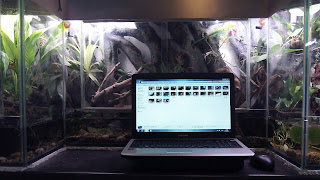I hadn't even heard of this species until recently. It's a South American water snake, similar to our Natrix or the North American Nerodia species.

The first three I received were in very poor condition, and two died within weeks, even though one had fed. I didn't get any autopsy results from these or faecal results until later. The faecals came back as nothing of interest (This was done as a parasitology test, obviously things could be missed, or of a bacterial nature but I think the main problem was the very poor condition of the snakes and their prior husbandry.)
The third refused dead food for a week, so I brought home a small platy, Xiphophorus maculatus, to try it on.
It obviously noticed it in the water and started to hunt, so I tong fed three small dead defrosted roach, which it took straight away. (I removed the platy.) This snake has fed very well ever since.
The next four I received were in good condition, and three started to feed on dead food within a week.
The fourth was a much quieter snake, staying on a piece of floating bark and not taking any interest in food.
I removed the three feeding snakes to another tank and offered the forth a platy; (can't remember if it was the same one). Once again the snake started to hunt so I tried feeding dead food with tongs. This was successful but only after repeated attempts- involving annoying the snake by knocking the food against its head until it struck. It then held and took a further two small fish straight away. Husbandry;
I first kept them in a 1 metre tank, mainly aquatic with floating cork bark and some plastic plants both in the water and on the wood.
The water had an internal filter and was heated to around 26oC. Out of each batch of snakes I received, all but one from each group was very aquatic, rarely if ever leaving the water. However the two that did sit on the wood were both the hardest to get feeding.
The tank that I moved the established snakes to had a much larger land area with a small spot lamp for basking. None of the snakes have been seen to bask and if placed on the land return to the water quite quickly.
Sloughing;
This is where Helicops get interesting! When they are going into slough they look like hell!
The largest animal often have a few isolated scales that look damaged (possibly with a fungal infection from being in water all the time?) Their eyes tend to be very cloudy for most of the time they are sloughing, but they rarely seem to stop eating.
At all stages of sloughing they will normally take food, even if it's obvious they can't see very well. This doesn't seem to be because they are really hungry as my largest snake (the original) will eat until obviously bloated, but still have to be removed days later when I'm trying to feed others because of his aggressive feeding behavior.
The two that seemed to be most unhappy when sloughing have left the water and sat quite dry until just about to shed. The first animal I removed from its tank and placed in a drier tank with a large water bowl which it didn't go into. I sprayed it daily until it sloughed. This animal fed but died soon after.
The second to have this "problem" was in the main tank which has a mister system, I overrode the mister timer a number of times a day to increase the humidity as the skin looked like it could crack, and to allow the snake to drink if it wanted to from water droplets. (It didn't).
Afterwards both snakes seemed fine and ate within a day or so of shedding. But as mentioned, these are the only 2 out of 7 that didn't actively feed even if apparently unable to see.
(Note, the second snake has just sloughed again and did feed while sloughing.)
Compatibility;
I have so far had no problems with keeping different sized snake together. I do make sure I remove the largest snakes when feeding and am ready to separate the others if there are any issues, but even when the largest are put back into the main tank I have had no problems. However, due to the very strong feeding response of this species I would always ere on the side of caution and separate or watch closely.
As I have little space and lots of things I want to keep I often have mixed enclosures, often multi taxa. With the Helicops I have a thriving population of the black chin live-bearers Girardinus metallicus which are too small to be of interest to them. Even if the snakes are actively hunting they seem to ignore even the largest female fish. Of course my snakes are reasonably large and juveniles would of course predate on these fish.
Water quality;
All the tanks I have had these snakes in have had mature biological filters and small water changes. The basic parameters have been based on London tap water; pH around 8. General hardness of around 14.6 DH.
It is very possible that the snakes would benefit from a lower pH, especially as they are soo aquatic. this would lower bacteria levels and possibly lower the incidences of infected looking scales.
I currently keep them in a tank that's fits around my lap top so when I'm working I can see them, and they can see me. There is often one or more with their heads just protruding above water waiting to be fed.
A top species indeed.
